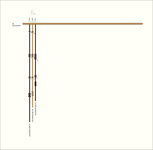AS055/KH0066 - Catalog Information
| Section | Information | |||||||||||||||||||||||||||
|---|---|---|---|---|---|---|---|---|---|---|---|---|---|---|---|---|---|---|---|---|---|---|---|---|---|---|---|---|
| Statistics: |
|
|||||||||||||||||||||||||||
| AS055/KH0066 |  |
|||||||||||||||||||||||||||
| DataFile: | AS055 |
|||||||||||||||||||||||||||
| Notes: | Ascher Databook Notes:
Excerpt from Ascher's Code of the Khipu (pages 149-151 Section 7.10) Khipu example 7.7 is AS055 and KH0067/html/KH0067_sketch.html">KH0067. We have modified one digit of one number on AS55 by one. As noted before, we do not consider an error of one in one knot cluster to be very significant, since errors in knotting or our errors in counting knots or in transcription are all possible. The last khipu example is, arithmetically, the most interesting. In all, it. contains only thirteen values, but their interrelationships are intricate and can be expressed in many different ways. Physically, it is two small khipus that were found together. One khipu has seven pendants and three subsidiaries and the other has just three pendants. Ignoring, for the moment, the first pendant and the subsidiaries, the khipus form a chart of values Pij (i=1,2,3; j=1,2,3) where values for i=1,2 are on the larger khipu and those for i=3 are on the smaller one. In tabular form, the chart is:
The values in the chart range from 734 to 2,427. One attractive relationship is that the product of the values in the third row is the geometric mean of the products of the first and second rows. That is: And, the product of the values in the third row is also the same as the product of the diagonal values: When comparing the individual values to each other, three simple fractions keep reappearing. They are 11⁄14, 7⁄8 and 34⁄33. The values in the third row, when multipled by these fractions, result in the values in the second row. And, the values in the first row, when multiplied by them in a different order (7⁄8, 34⁄33, 11⁄14), result in the third row. This cyclical relationship can be summarized by:
Closer scrutiny of the values in the first row shows that they, too, are related to each other by these fractions. Specifically:
All the relationships already described can be seen from this formulation. For example, both the product of the values on the diagonal and the product of the values in the third row are C3B6x2y. And, of course, additional ones can now be found. For example, the products of the off diagonal values p12 , p23 , p31 and of p13, p21 p32 are the same as the product of the diagonal values. The values on this khipu pair must have resulted from intentional calculations. The interrelationship of the values depends on fractions and on logic that is more complex than is used to yield values that are consistent fractional parts of their whole. But, if the two small khipus were not together, it is unlikely that any of the relationships would be seen. |